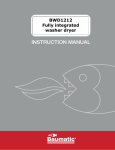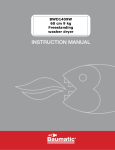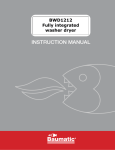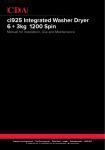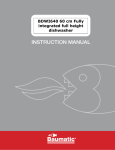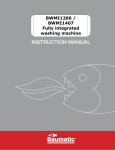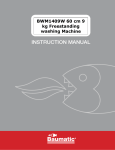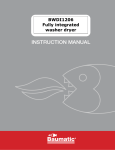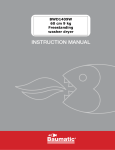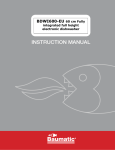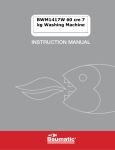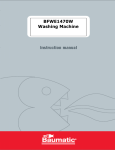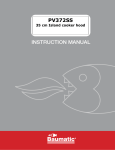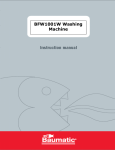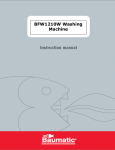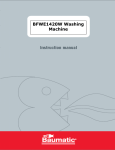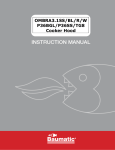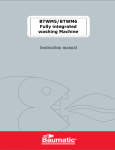Download Baumatic BWD1206SL washer dryer
Transcript
BWD1206SL-W Washer - Dryer Machine USER MANUAL FOR YOUR BAUMATIC BWD1206SL-W 60 cm 6 kg Washer - Dryer machine NOTE: This User Instruction Manual contains important information, including safety & installation points, which will enable you to get the most out of your appliance. Please keep it in a safe place so that it is easily available for future reference; for you or any person not familiar with the operation of the appliance. GS 03/03/11 2 Contents Environmental note 4 Important safety information 5–6 Specifications 7 Description of the appliance Control panel Control panel functions Detergent drawer 8 - 11 9 9 - 10 11 Preparing the wash cycle Preparing your garments for washing A selection of wash care symbols Detergents and conditioners 11 - 14 11 - 13 13 14 Wash program table Wash program guidance 15 15 - 16 Selecting a wash program Descriptions of the wash programs Pausing a wash program Delay start feature Child lock 16 - 18 16 - 17 17 17 - 18 18 Maintenance and cleaning In daily use Control panel and washing machine cabinet Detergent drawer The washing machine drum Door Cleaning the drain pump filter Cleaning the water inlet filter Winter storage Moving the machine Removing stains Stain removal rules Stain removal guide Poor wash results 18 18 19 19 19 20 20 21 21 22 23 23 23 25 Installation Removing the transit bolts Locating your washing machine Connecting to the mains water supply Connecting to the water outlet Levelling the appliance Power supply Before first use maintenance wash 26 – 31 26 - 27 27 28 28 - 29 29 30 30 Error code failure system General troubleshooting 31 – 33 32 – 33 Contact details 34 - 26 - 19 - 20 – 21 - 24 - 26 3 Environmental note 4 Important safety information Your safety is of the utmost importance to Baumatic. Please make sure that you read this instruction booklet before attempting to install or use the appliance. If you are unsure of any of the information contained in this booklet, please contact the Baumatic Customer Care Department. General Safety o Repairs to your appliance must only be carried out by a Baumatic engineer or one of its authorised service agents. Any attempt by an inexperienced person to repair the appliance, could result in injury or damage to your washing machine. o If you notice that the mains cable is damaged. The appliance must not be used. The same applies if you notice that the worktop, control panel or base area is damaged. As this could allow access to the internal components of the machine. o The appliance should be turned off and isolated from the mains supply, before either cleaning or maintenance work is attempted. o The mains cable must not be used to pull the plug out of the electrical socket. o The machine should not be sprayed with water. o The glass of the porthole door may become hot during the higher temperature wash programs. o The machine should be allowed to cool before carrying out an emergency drain or cleaning the drain filter. o It is possible for small animals to chew either the mains cable or water hoses, which could cause an electric shock hazard. Installation o The installation instructions contained within this user manual should be followed. o It is obligatory for the completed installation to comply with all relevant building regulations and local water authority requirements. 5 o Before the first use of the appliance, we advise that a 95 degree cotton wash is completed. No garments should be placed inside the machine; however a small amount of detergent must be used. During Use o It is recommended that the appliance is unplugged and the water supply is turned off after the machine is used. o This appliance is only designed to wash normal domestic washloads. If you use your washing machine in any other way or it is incorrectly used, then Baumatic accepts no liability for any damage that might be caused and any guarantee will be void. o No attempt should be made to alter or modify the specifications of this appliance. o The detergents that you place in this appliance should be suitable for automatic washing machines. With regards to dosage levels, the detergent manufacturer’s recommendations should be followed. o You should not wash garments that have been in contact with flammable materials. o Your washing machine should not be used for dry cleaning. o If you use either dyes or bleaching agents inside this machine, then you should consult with the manufacturer of these products to make sure they are suitable for use in your washing machine. Baumatic cannot be held responsible for any damage that may result. Child Safety o Your washing machine should only be used by adults. You should not allow children in the area of the machine unsupervised. You should not let them touch the controls or play with the appliance. o It could be possible for a child or pet to gain access to the washing machine through the porthole door. Therefore please check the drum before using the appliance. o Any packaging that is removed from the machine should be kept away from children. o All detergents should be kept out of a child’s reach and in a safe place. 6 Specifications o o o o o 7 wash programs 3 Drying programs 6 kg wash load 3 kg drying load 1200 rpm maximum spin speed o o o o o o o o o o o o o o o o o o LED display Delay start Drum size: 46 litres Porthole diameter: 300 mm Electronic control operation Wash phase indicator Adjustable spin speed Digital countdown indicator Block filter indicator Self-adjusting water level to load Automatic consumption reduction Failure detection system Imbalance control system Overflow protection Safety-lock Half load Anti-crease function Adjustable feet Appliance Height: Width : Depth: dimensions 850 mm 595 mm 590 mm Ratings Energy efficiency class (wash only) Energy efficiency class (wash and dry) Wash performance class Water extraction performance class A C A B For future reference please record the following information which can be found on the rating plate and the date of purchase which can be found on your sales invoice. The rating plate for your washing machine will either be located on the right hand side of the cabinet or behind the porthole door. Model Number ………………………………. Serial Number ………………………………. Date of Purchase ………………………………. 7 Description of the appliance Accessories 1 x Inlet hose assembly 1 x Drain hose bracket 1 x Instruction manual 3 x Blanking plugs 8 Control panel A) Power button B) Program selection dial C) Detergent drawer D) Spin speed setting button E) LED display F) Wash status indicator G) Start / pause button H) Eco wash button I) Dry cycle button J) Extra rinse button K) Delay start button L) Wash temperature button Control panel functions A) Power button: Press this button once to turn the machine on and once again to switch it off. B) Program selection dial: Turn the dial clockwise or anticlockwise to select the required program. 9 C) Detergent drawer: Instructions are printed on the front of the drawer. See below section for further details. D) Spin speed setting button: Press this button to select the required spin speed. E) LED display: Information such as remaining wash time, temperature and spin speed setting and error codes are shown here. F) Wash status indicator: This light shows the stage of the cycle in the selected program. G) Start / pause button: Press this button to begin operation. Press this button again during operation to pause the program. The display screen will start blinking and the machine will be paused. Press this button again and the program will continue. H) Eco wash button: This function automatically adjusts the water consumption, wash time and temperature to make the cycle more environmentally friendly. I) Dry cycle button: Press this button and the corresponding light will go on and the appliance will dry the laundry after the last spin cycle. J) Extra rinse button: Press this button and the overhead indicator will go on. An additional rinse operation will be activated to obtain a better rinse performance. K) Delay start button: Use this button to set a delay starting time for your wash cycle. See the appropriate section later in this manual. L) Wash temperature button: Press this button and the wash temperature will be displayed on the screen. Select a suitable temperature according to the type of laundry. 10 Detergent drawer 1) Pre wash section This compartment should have detergent placed in it, if you are going to select a pre-wash before the main wash cycle. 2) Main wash section This compartment should have detergent placed in it (you should also put a water softening agent in this section, if you use one). The detergent will be added to the drum at the start of the main wash program. 3) Conditioner section This compartment should be used for liquid conditioners (fabric softener, starch). They will be added to the wash load during the final rinse. Preparing the wash cycle Preparing your garments for washing o Your washing should be sorted out, according to the fabric type and the wash care symbol that is printed on the garment’s wash care label (see separate section on wash care symbols). o Your washing should also be sorted out according to the degree of soiling. 11 o Check all pockets on a garment to make sure that they are empty. o Remove any detachable metal items (badges, paperclips, safety pins etc). o Zips should be closed, duvet covers and pillow cases should be buttoned up and any loose straps should be tied up. This will help to prevent other garments from getting damaged during the wash. o Woolens and knitted coloured fabrics should be turned inside out before being washed in the appliance. o Small delicate items (tights, baby socks) should be placed in either a washing net or a zipped pillow case. o Curtains should be handled with particular care. All plastic hooks or metal strips must be removed before being washed in the appliance. o Coloured items and whites should be washed in separate wash cycles. o New garments often contain an excess of dye, therefore it is advisable to wash them separately for their first wash. o Garments should be unfolded and shook out before being placed inside the machine. Wash load The maximum wash loads for the main programs are as follows: Cotton Synthetic Delicate Quick wash Pre-wash Spin Wash Dry Rinse 6 kg 3 kg 2 kg 3 kg 6 kg 6 kg 6 kg 3 kg 6kg 12 For optimum wash results, please consult the load reference table below: Laundry item Fabric Bed sheet (single) Blanket Blended fabric clothes Jackets Jeans Overalls Pajamas Shirts Socks T-Shirts Underwear Cotton Wool N/A Cotton N/A Cotton N/A N/A Blended fabrics Cotton Blended fabrics Approximate wash load (g) 800 3000 800 800 800 950 200 300 50 300 70 A selection of wash care symbols Washing Boiling temp 95°C Normal temp 60°C Normal temp 40°C Do not wash! Bleachable in cold water Do not bleach! Wool seal Delicate temp 30°C Delicate temp 40°C Hand wash only All solvents All but TRI Benzine only Do not clean! Normal Low High Hang to dry Drip dry Dry flat 110°C 150°C 200°C Dry cleaning Spin dryer Do not dry! Ironing Do not iron! o The wash care symbols should be used to help you to select the most suitable wash program. They will also help you to sort your laundry into different loads, depending on the fabric type and the highest temperature which the garment can be washed at. 13 Detergents and conditioners The amount of detergent that you need to use in your appliance, will depend on o The degree of soiling. Lightly soiled garments in general require less detergent. o The size of the wash load. A smaller wash load will require a reduction in the amount of detergent. o The hardness of your tap water. The harder your water is, then the more detergent you will need to use. The detergent manufacturers normally give guidance as to how much extra detergent should be used, depending on the hardness of the water. Liquid detergent If you are using liquid detergent, then in the majority of cases the liquid should be placed inside the dosing device supplied by the detergent manufacturer and placed inside the drum. All instructions on the detergent packaging should be followed. Water softening agents If your tap water is hard, then it may be prudent to utilise a water softening agent. This will help to ensure that the appliance does not become clogged with hard water deposits. You may also find that it will allow you to lessen the amount of detergent that you are using. When using any detergent or water softening agent, the recommendations of the manufacturers should be followed. 14 Wash program table Program Maximum temperature (°C) Preset temperature (°C) Pre-wash Cotton and linen Synthetics 90 90 Recommended laundry 40 40 Detergent drawer compartments used 1,2,3 2,3 60 40 2,3 Wool Quick wash 40 40 0 0 2,3 2,3 Wash 60 40 2,3 Rinse 0 0 3 Spin 0 0 None Synthetic fabrics Wool fabrics Lightly soiled cotton, linen and synthetic fabrics Cotton, linen and synthetic fabrics Cotton, linen and synthetic fabrics Cotton, linen and synthetic fabrics Cotton, linen and synthetic fabrics Cotton, linen and synthetic fabrics Cotton, linen and synthetic fabrics Dry The laundry is completely dry when the cycle is complete. Iron The laundry is completely dry when the cycle is complete. Air wash Air refresh wash for small items that need a quick refresh e.g. school uniforms. Heavily soiled Cotton fabrics Default spin speed (rpm) 1000 1000 800 600 800 N/A 800 1000 N/A N/A N/A Wash program guidance o The washing machine automatically selects a temperature for a particular wash program. However it is possible to alter the temperature by using the temp button. All temperatures will not be available on certain wash programs. o The washing machine automatically selects a spin speed for a particular wash program. However it is possible to alter the spin speed by using the spin button. All spin speeds will not be available on certain wash cycles. o Important: You should make sure that the selected spin speed is appropriate for the garments that you are washing. o Important: Before opening the door of the appliance, you MUST spin the clothes and drain the water. 15 o The active phases will appear at the top of the LED display, as the wash program progresses. o The LED display shows an approximate time for the selected wash cycle. Please note that factors external to the machine, e.g. the temperature of your water supply, your water pressure etc. can affect the time it takes for a wash cycle to complete. For a general guide, please see the table below: Program Pre-wash Cotton and linen Synthetics Wool Quick wash Wash Rinse Spin Dry Iron Air wash Energy consumption (kWh) 0.637 0.482 Water consumption (L) 68.3 58.4 Approximate washing time (min) 133 133 0.288 0.225 0.018 0.341 0.038 0.033 4.227 0.888 0.446 34.1 30.8 30.4 12.1 32.7 0 111.4 23.5 11.76 72 60 12 61 24 11 150 60 30 Selecting a wash program Setting a wash and dry program o Press the ON / OFF button (A). o Rotate the program selection dial (B) to set the required program. o If you wish to add a dry cycle to the program, press the dry cycle button (I) before the wash cycle beings. o Press the start / pause button (G) to begin the wash and dry cycle. o If you press the dry cycle button (I) a second time before the wash cycle starts this will turn off the dry cycle. Setting a wash program only o Press the ON / OFF button (A). o Rotate the program selection dial (B) to set the required program. Wash only programs available are Cotton and linen, Synthetics, Wool, Quick wash and Wash. o If you wish to set a pre-wash to a program, rotate the program selection dial (B) to the pre-wash option and the washer-dryer 16 will proceed to carry out a pre-wash followed by a standard cotton and linen wash cycle. o Press the start / pause button (G) to begin the wash cycle. o If you press the extra rinse button (J) before the cycle starts, the machine will add this function to your wash program. o Before you start the cycle you can also adjust the spin speed and wash temperature by pressing the relevant buttons. Setting a dry cycle only o Press the ON / OFF button (A). o Rotate the program selection dial (B) to set the required program. Drying only cycles available are Dry, Iron and Air wash. o Press the start / pause button (G) to begin the drying cycle. o The final part of a drying cycle is a cooling cycle without heat to ensure that the dried items are left at a temperature that keeps them undamaged. Pausing a wash program o If you want to pause a wash program temporarily, you should press the start / pause button (G). o When you want to restart the wash cycle, press the start / pause (G) button again. Delay start feature Your appliance has a delay start feature, which allows you to delay the start of a wash cycle until a later time. o Put the laundry into the drum and close the door. o Press the delay start button (K) repeatedly before starting the program to enter the time you want the machine to be finished by. o The start time can be delayed from 30 minutes to 24 hours. By pressing the button the time will increase in 30 minute intervals. 17 o After the desired delay time is selected, press the start / pause button (G) to start the countdown. The countdown time is displayed on the screen until the program ends. IMPORTANT: The delay time must be longer than the program time otherwise the washer-dryer will start the wash programme immediately. Child lock Your appliance has a child lock option, if this is set, it will mean that nobody can affect the operation of the wash program once it has started. o Press the delay start button (K) and the start / pause button (G) simultaneously for about 3 seconds after starting a program. The settings cannot be changed using the operating buttons or dial while the lock is activated. The machine emits an audible signal while the control panel is locked. o To release the safety lock, press the delay start button (K) and the start / pause button (G) simultaneously again for about 3 seconds. Maintenance and cleaning In daily use o Once a wash cycle has completed, you should pull out the detergent drawer slightly, so it can dry out. o Leave the porthole door ajar for a short while after a wash cycle has completed. This should help to prevent stagnant smells and to protect the door seal. o Close the water tap. 18 o We suggest that you disconnect the appliance from your mains supply, when it is not in use. Control panel and washing machine cabinet. IMPORTANT: Do not use any abrasive cleaner or household polish on either the control panel or operating parts. o Wipe over the control panel and the external surface of the machine using a brand new damp cloth with warm water. o If you ever spill any liquid detergent or conditioner from the detergent drawer onto the washing machine cabinet, then these should be cleaned up immediately as they could be corrosive. Detergent drawer Occasionally the detergent drawer should be cleaned, to remove any detergent residue that has built up. o Pull the detergent drawer out as far as it will go, press down the catch in the middle section of the drawer and then pull the drawer out. o Wash the detergent drawer in warm, soapy water. For ease of cleaning, you can remove the upper part of the fabric softener compartment. o Detergent can also accumulate inside the detergent drawer recess, so you should also clean this out using a brush o Once you have finished cleaning the detergent drawer and recess, you should slide the drawer back into its original position. The washing machine drum The drum of your washing machine is constructed from stainless steel. However if there are objects that can rust placed inside the drum, then it is possible for the drum to become stained. IMPORTANT: Do not use a descaling agent, iron/steel wool or scouring agents to clean the drum of your appliance. 19 o Remove any rust stains on the drum with an appropriate stainless steel cleaning agent. Door o You should regularly check to see if any deposits have formed, or there are any foreign bodies inside or underneath the rubber door gasket. This sits inside the opening of the porthole door. Cleaning the drain pump filter IMPORTANT: Switch off your washing machine and disconnect the plug from your mains supply. You should clean out the filter approximately every ten washes. If the drain pump filter is not cleaned regularly, then your appliance may find it difficult to pump out water efficiently. o You should regularly check to see if any deposits have formed, or there are any foreign bodies in the drain pump filter. o Locate the drain pump filter flap that is on the base of the appliance in the front right hand corner. 1) Open the drain pump filter flap. 2) Remove the filter by turning it anti-clockwise. 3) Wash the filter thoroughly with clean running water. 20 4) Replace the filter by turning it clockwise. Refit the filter flap. IMPORTANT: If you are draining water from the bail hose and drain pump filter in an emergency. You should take care as the water coming from the machine mid-cycle could be hot. Especially if the water is being drained in the middle of one of the hotter wash cycles. Cleaning the water inlet filter o Clean the filter when water leaks from the water inlet. o Always pull the power plug out before cleaning. o Turn off the water supply to the washer and separate the inlet hose. o Pull the inlet filter out. Remove the dirt from the inlet filter with a brush and replace. Winter storage o You should install your appliance in a location where it will not be subjected to freezing temperatures. o If you are going to store your appliance in a location where the temperature will drop below freezing in winter, then you should follow the table below. To winterize the washer • Turn off the water supply. • Disconnect and drain the water inlet hoses. • Run the washer on a drain and spin setting for one minute. • Unplug the power supply cord. To use the washer again • Flush the water pies and hoses. • Reconnect the water inlet hoses. • Turn on the water supply. • Reconnect the power supply cord. 21 Moving the machine If the washer-dryer needs to be moved to another location, replace the transportation locks removed before installation to prevent damage. Follow the steps outlined below: 1) Remove the blanking plugs. 2) Remove the back cover. 3) Insert the synthetic transportation bolts. stabilizers and the 4) Tighten the bolts with a spanner. 5) Replace the back cover. 22 Removing stains Garments that are covered in stains, grease or are heavily soiled may need to be pre-washed or soaked before being placed inside of the washing machine. o Soaking helps to remove protein-type stains, like blood, milk or grass. o Pre-washing helps to loosen soil before the main wash. Stain removal rules o Use warm water for soaking or pre-washing stained laundry. Hot water can set stains. o Most stains are easier to remove when they are fresh. o Before treating any stain try to establish; what kind of stain it is, how old the stain is, what the fabric type is and whether the fabric is colourfast (check the care label to find this out). o Washing and drying can fix some stains. o When bleach is recommended, use a mild fabric bleach that is safe for the fabric. o If you need to use a stain remover, put the stained area face down on a paper towel or white cloth. Apply the stain remover to the back of the stain. This forces the stain off the fabric, instead of through it. Stain removal guide Stain Alcoholic beverages Shoe polish Tea and coffee Chocolate and cocoa Removal Method The stain should be first washed with cold water, then wiped with glycerine and water and rinsed with water mixed with vinegar. The stain should be softly scratched without ruining the material, then rubbed with detergent and rinsed. In case it is not eliminated, rub with 1 unit of pure alcohol (96 degrees) mixed in 2 units of water and then washed with lukewarm water. Stretch the stained area of material on the top of a container and pour water as hot as the material can endure on it. If the type of material is suitable, wash it with lye. Leave your clothes in cold water and rub with soap or detergent, wash it in the highest temperature that the material type can endure. If there is still a stain of oil left, wipe with oxygenated water (in proportion of 3%). 23 Tomato paste Scrape the dried pieces without ruining the material, then leave in cold water for about 30 minutes and wash by rubbing with detergent. Meat broth/ egg Eliminate the dried stain residues and wipe with a sponge or soft cloth wetted in cold water. Rub with detergent and wash with diluted lye. Grease and oil stains First wipe the residues. Rub the stain with detergent and then wash with lukewarm soapy water. Mustard First apply glycerine to the stained area. Rub with detergent and then wash. If the stain still does not disappear, wipe with alcohol (on synthetic and coloured cloth, a mixture of 1 unit alcohol, 2 units water should be used). Lay your clothes in cold water for 30 minutes. If the stain still does not disappear, lay in mixture of water and ammonia (3 table-spoons of ammonia in 4 litres of water) for 30 minutes. Lay your clothes in cold water and rub the stained area with detergent. If the stain has still not disappeared, apply lye on the fabric of your clothes in proper proportion. (Do not use lye on coloured clothes). Mould stains should be cleaned as soon as possible. The stain should be washed with detergent, and if it does not disappear, it should be wiped with oxygenated water (in proportion of 3%). Hold the stained area under cold water and wait until the inky water completely runs off. Then rub with water diluted with lemon juice and detergent. Wait five minutes and then wash. Stretch the stained area of your clothes on the top part of a container and pour cold water on it. Do not pour hot water on the stain. Wipe with cold water and apply glycerine. Wait for 1-2 hours and rinse after wiping with a few drops of white vinegar. Rub the stained part with detergent. If the type of fabric is suitable for use of lye, wash it with lye. Rub your woolen clothes with alcohol (for coloured one, a mixture of 1 unit pure alcohol and 2 units of water). The stain should be eliminated before it dries by applying thinner on it. Then it should be rubbed with detergent and washed. Blood stain Cream, icecream and milk Mould Ink Fruit Grass stain Oil paint Burnt stain If your fabric is suitable for use of lye, you can add lye into your washing water. For woolen fabric, a cloth dampened in oxygenated water should be pressed on the stain and it should be ironed with a dry cloth on it. It should be washed after rinsing well. 24 Poor wash results My garments are looking grey and there are limescale deposits present in the drum of my washing machine. o o o o There is not enough detergent being added. The incorrect detergent is being used. Stains are not being pre-treated. The correct wash program or wash temperature was not selected. I have followed the advice given above, but my garments are still coming out with grey stains on them. o The garments are soiled with oils, ointments or grease and were washed without enough detergent. o The wash temperature selected was too low. o Fabric conditioner has come into contact with the garments. If this happens try to wash out these stains as quickly as you can and try to avoid getting conditioner on the garments in future. After the final rinse, I can still see foam. o Modern detergents can result in there still being foam in the final rinse, this does not mean that the washing is not being rinsed properly. There is white residue on my garments when I remove them from the appliance. o Modern detergents can contain insoluble contents; white residue after a wash cycle is not necessarily a sign of the garments being insufficiently rinsed by the washing machine. o You should shake out the garment or brush it off. In future possibly turn the garment inside out before it is washed. You may wish to 25 move from a powder detergent and switch to a liquid detergent instead. Installation IMPORTANT: THIS INSTALLATION MUST BE COMPLETED BY A SUITABLY QUALIFIED PERSON. BAUMATIC ONLY SANCTION THE INSTALLATION GIVEN IN THIS INSTRUCTION MANUAL. YOU SHOULD KEEP THE TRANSIT PACKAGING, IN CASE YOU NEED TO TRANSPORT THE MACHINE IN THE FUTURE. Removing the transit bolts IMPORTANT: Before installing or operating the washing machine, YOU MUST remove the transit bolts that hold the drum in position whilst the appliance is being transported. The transportation bolts are designed for clamping anti-vibration components inside of the washer-dryer during the transportation process. 1) Remove the back cover. 2) Remove the three bolts on the rear side and take out the synthetic stabilizers from within the machine. 3) Replace the back cover. The convexity must face to the outside and the back cover must be inserted from the two gaps. 26 4) Fill the holes left by the bolts with the blanking plugs. IMPORTANT: Keep the transportation bolts and synthetic stabilizers in a safe place for later use. Locating your washing machine o Before commencing installation, check the location where you intend to install the appliance. You should make sure that you have everything in place that is necessary for the correct installation. o Do not place or store your washing machine in a location where the ambient temperature could fall below 0°C, otherwise the water in it could freeze up. o Never place or store laundry products on top of the appliance. o Install the washer on a flat, solid floor. If the washer is installed on an uneven or suspended floor, it could cause excessive noise and severe vibration, which may result in the malfunction of the appliance. o You should also level off the washing machine, using the adjustable feet on the base of the appliance. o There should be a gap of 2 cm either side of the washing machine; a 10 cm gap should be left behind the appliance. 27 Connecting to the mains water supply IMPORTANT: The washing machine should never be connected to the water mains using an existing inlet hose, YOU MUST utilise the inlet hose that is provided with the appliance. Your appliance should only be connected to a cold water supply. 1) Connect and fully tighten the inlet hose to the threaded inlet valve that is located at the rear of the washer dryer. You should connect the end with the right angle connector on it to the back of your appliance. 2) Connect the other end of the inlet hose to your mains water supply. IMPORTANT: There should be a filter sitting inside the end of the inlet hose that connects to your mains water supply. The inlet hose may leak if this filter is missing. This filter is supplied with the appliance, you should contact Baumatic to obtain one, if it is missing. o Tighten the inlet hose to your mains supply fully, but do not over tighten as this may distort the filter that sits in the end of the inlet hose. o Test for any leaks. Connecting to the water outlet 1) Use the drain hose bracket to keep the end of the drain hose retained and prevent the outflow of water. Don’t extend the length of the drain hose. 28 2) The height of the drainage outlet must be 80 – 100 cm. Fix the drain hose to the clip at the back of the washer-dryer to prevent it from dropping off. IMPORTANT: Do not insert the drain hose too deeply into the water pipe, as this may cause siphoning. NEVER EXTEND THE DRAINAGE HOSE FROM ITS ORIGINAL LENGTH. Leveling the appliance o Place the washing machine on a solid and level floor surface. If the washer is installed on an unsuitable floor, it could make considerable noise, vibrate and cause a malfunction. DO NOT PLACE THE WASHING MACHINE ON A CARPET OR A SUSPENDED FLOOR. o Adjust the level of the washer-dryer using the adjustable feet. Check if there is any gap between the feet and the floor and adjust the feet accordingly. o Turn the adjustable feet using a spanner to level the machine and ensure that it is stable. o Adjust the fixing nuts tightly so that the washer-dryer maintains the change. o Make sure that the machine does not move when you press down the four corners of the washer’s top plate. IMPORTANT: There should be no instability of the machine when the adjustable legs have been set to the correct level. 29 Power supply 9 IMPORTANT: The electrical socket must still be accessible once the appliance is installed. o Consult the rating plate, located on the machine BEFORE making the electrical connections. Ensure that the voltage reaching the plug is the same as that on the rating plate. o DO NOT REMOVE THE RATING INFORMATION ON IT IS IMPORTANT. PLATE AS THE o The moulded plug that is supplied with the appliance must be placed into an earthed and insulated socket. o Broken or damaged power leads must only be replaced by a suitably qualified person. A power lead of a similar type must be used in replacement. o IMPORTANT: We do not recommend that this appliance is connected to an extension lead. Before first use maintenance wash o When your washing machine has been correctly installed, we recommend that you perform a maintenance wash cycle, without any clothing being placed inside of the drum. o This will check that all aspects of the installation are correct; it will also remove any deposits that may have been left on the drum by the manufacturing process. o Select a 90°C cotton wash. o A small quantity of maintenance wash. detergent should be used during this 30 Error code failure system If your appliance senses that it is not operating correctly, then an error code may appear on the LED display. The following error codes can possibly be remedied by the customer and the steps outlined below should be followed. BEFORE COMPLETING ANY MAINTAINEANCE ON APPLIANCE, IT SHOULD BE DISCONNECTED FROM YOUR POWER SUPPLY. Error code Err 1 Possible causes o Err 2 o Err 3 Err 4 THE Solutions Washer door is not properly shut. Drainage error. Water is not emptied within 4 minutes. o Shut the door properly. o o Temperature sensor error. o o Heater error or laundry overload. The set temperature is not reached within specified time (appears at the end of a cycle). Water level not met within 8 minutes. Dehumidification / heating error. Motor overheat error. o Clean the filter and check the drain hose for blockage. Remove the filter in case any water remains in the unit. Please contact the customer care helpline. Reduce load and start washing again. Please contact the customer care helpline. Err 5 o Err 6 o Err 7 o Err 8 o Err 9 o Er 10 o Er 12 o Er 13 o Unb o EUAr o 1:16 o 0:01 60 °C o o o Check the tap and the water pressure. o Please contact the customer care helpline. o Please contact the customer care helpline. Water overflow. o Please contact the customer care helpline. Error of the dryer o Please contact the customer temperature sensor. care helpline. Error of the water level o Please contact the customer sensor. care helpline. Error of the dryer water level o Check whether clothes are dry sensor. or not and whether there is water still in the drum. If so, allow excess humidity to escape from the appliance and try the drying cycle again. Dryer heater error. o Please contact the customer care helpline. Laundry is unevenly o Redistribute laundry to balance distributed. the drum. Communication error. o Please contact the customer care helpline. Status information: remaining program time is 1 hour and 16 minutes. Status information: remaining program time is 1 minute. Status information: wash temperature is 60 °C. o 31 -- °C 0 800 L--1 L--A End o o o o o o No heat (cold wash). No spin Status information: spin speed 800 rpm. Manually selected code when laundry weight in less than 1 kg. Manually selected code when drum is nearly full. Program is finished. If a fault code reappears after following the above advice and clearing the fault code. You should turn the washing machine off using the POWER button. Disconnect the appliance from your mains supply. Then arrange for an engineer to attend the appliance. You should contact the Baumatic Service Department on (0118) 933 6911. IF AN ENGINEER ATTENDS DURING THE GUARANTEE PERIOD AND FINDS THAT A FAULT HAS BEEN CAUSED BY AN ITEM ON THE ERROR CODE LIST, WHICH COULD HAVE BEEN CLEARED BY THE CUSTOMER. THEN YOU MAY BE LIABLE FOR THE COST OF THE SERVICE CALL. General troubleshooting Problem Washer-dryer fails to operate. o o o o Washer-dryer cannot be filled with water. o o o o o o Machine is continually filling and draining. o o Possible causes Poor connection to the power supply. Power failure. The washer door is not properly closed. Machine has not been switched on. Water tap is not turned on. Water pressure is less than 0.03 MPa. The inlet hose is kinked. Water supply failure. The program selection dial is not properly set. The washer door is not properly closed. The height of the drain hose is below 80 cm. The drain hose is in water. Possible solutions o Check connection to the power supply. o Check the power supply. o Make sure the washer door is closed properly. o Make sure the machine is switched on. o Turn water tap on. o Check water pressure. o Check the inlet hose for bends. o Ensure the water supply is connected. o Make sure the program selection dial is properly set. o Make sure the washer door is closed properly. o Make sure the height of the drain hose is within 80 – 32 o Drainage failure. o o o Strong vibration while spinning. o o o Drain hose is blocked. Drain hose end is more than 100 cm above the floor level. The filter is blocked. Not all transportation bolts have been removed. Washer-dryer is located on an uneven floor surface or is not level. Machine is overloaded. o o o o o o Operation stops before completing wash cycle. Operation stops for a period of time. Excessive foam in the drum. o Water or electricity failure. o o Washer-dryer gives an error message. o o o o Automatic adjustment of the washing time. o Spinning fails. o The detergent is not a lowfoaming type or for manual wash. Excessive use of detergent. o The washing program duration will be adjusted according to the initial water temperature. Unbalance of the laundry. o o o 100 cm. Make sure the drain hose is not in water. Unblock the drain hose. Make sure the drain hose end is less than 100 cm above floor level. Unblock the filter. Check if all transportation bolts have been removed. Make sure the washer-dryer is on an even surface and leveled. Reduce amount of laundry in the drum. Check the power supply. Wait until cycle is complete. See display codes on previous page. Check if your detergent is appropriate. Reduce amount of detergent used. This is normal and does not affect the functionality. Add clothes or run a spinning program again. IMPORTANT: Your appliance has an unbalance control system. If this system detects that the washload is unevenly distributed inside the drum. Your washing machine will try to redistribute the load before spinning. If after several attempts it is unable to redistribute the washload, then the appliance will either spin at a slower speed or skip the spin cycle and proceed to the drain section of the wash cycle. Uneven load distribution can be caused by too large a wash load or too small a wash load. It can also occur if a single item if washed inside the appliance. 33 United Kingdom Baumatic Ltd., Baumatic Buildings, 6 Bennet Road, Reading, Berkshire RG2 0QX United Kingdom Czech Republic Baumatic CR s.r.o. Lípová 665 460 01, Liberec 4 Czech Republic Sales Telephone (0118) 933 6900 Sales Fax (0118) 931 0035 Customer Care Telephone (0118) 933 6911 Customer Care Fax (0118) 986 9124 Spares Telephone (01235) 437244 Advice Line Telephone (0118) 933 6933 www.baumatic.cz E-mail: [email protected] [email protected] [email protected] [email protected] Website: www.baumatic.co.uk Republic of Ireland Service Telephone 1-890 812 724 +420 483 577 200 Slovakia Baumatic Slovakia, s.r.o. Galvániho 7/D Slovakia +421 255 640 618 Germany Baumatic Gmbh Lilienthalstrasse 1 320 52 Herford Deutschland +49 5221 694 99-0 www.baumatic.de Italy Baumatic Italia S.R.L. Via Galvani N.3 35011 Campodarsego (PD) +3904 9920 2297 www.baumatic.it Spares Telephone 091 756 771 Holland Baumatic Benelux B.V. Grindzuigerstraat 22 1333 MS ALMERE Nederland +3136 549 1555 www.baumatic.nl 34 2




































